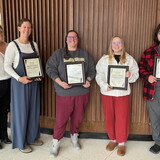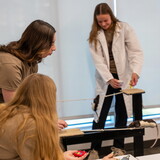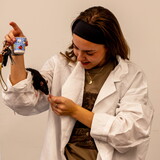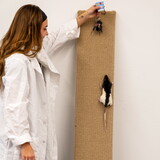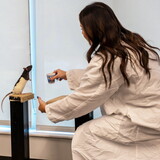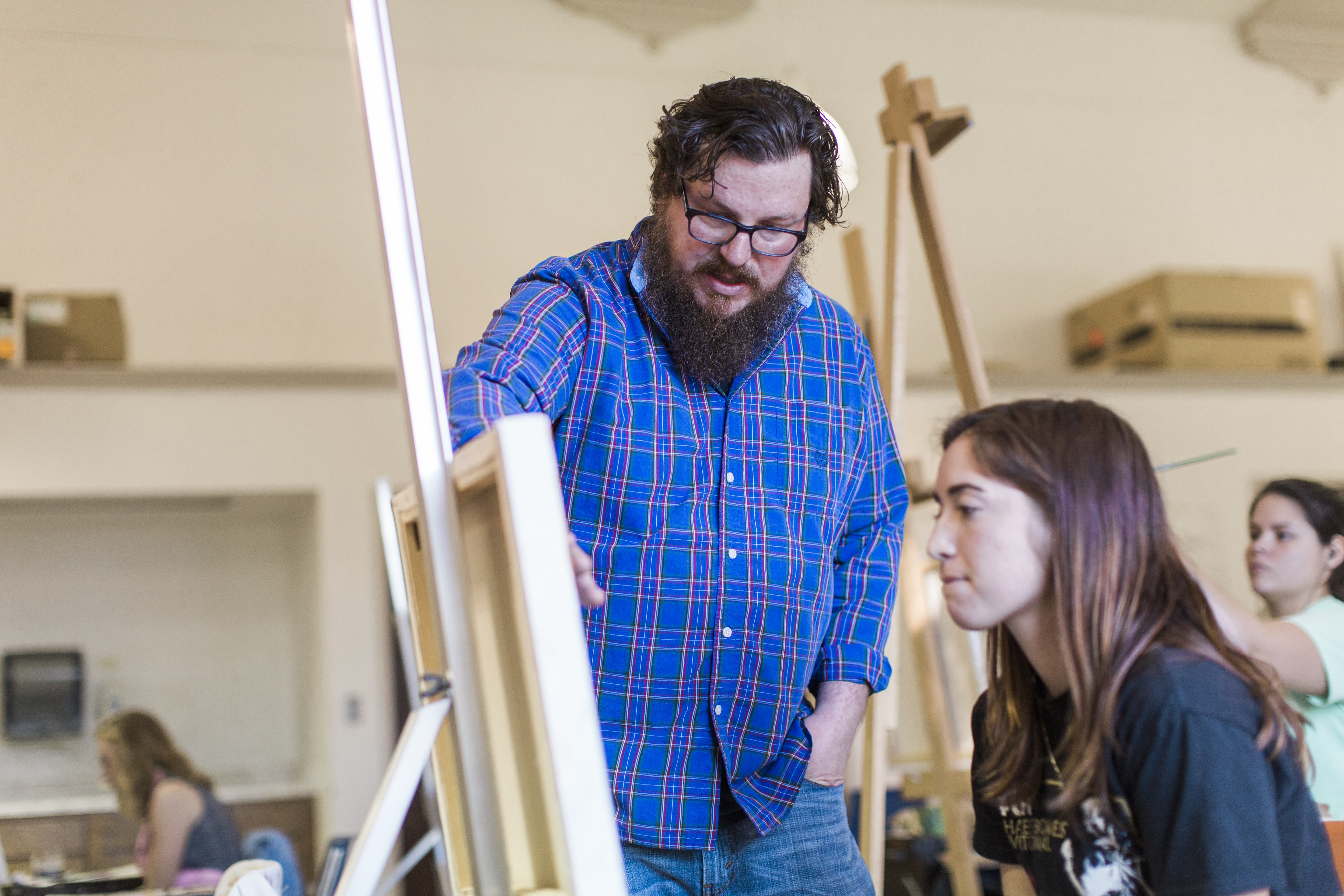The work of the late realist artist Stephen Brown will be featured at NWU’s Elder Gallery later this month. The exhibit is entitled The Aching Beauty of it All: Paintings by Stephen Brown. This will mark the first time the artist’s work has been exhibited in Nebraska.
The exhibition features over 70 paintings spanning the late artist’s career. Born in Greeley, Colorado, Brown spent his career in New York City and New England. He received The Academy Award for Painting from the American Academy of Arts and Letters, The Gladys Emerson Cook Prize from The National Academy of Design, and the Benjamin Altman Prize for a landscape done by an American citizen from the National Academy of Design. Brown is the subject of numerous one-person museum and gallery exhibitions.
The exhibit was curated by Associate Professor of Art David Gracie, who was Brown’s student at the Hartford Art School. Gracie also produced a catalogue and essay for the occasion. The exhibit opens on November 9 with a reception on November 12 from 5-7 p.m.
Elder Gallery is located in the Rogers Center for Fine Arts on the Nebraska Wesleyan University campus. Admission is free.
The Aching Beauty of it All: Paintings by Stephen Brown - An Essay by Associate Professor of Art David Gracie
I was nervously awaiting my professor’s arrival on the first day of Painting Composition class at the Hartford Art School in the late 1990’s. With one foot out the door, Professor Stephen Brown appeared and waved his arms directing us outside. The weather was beautiful out. The edge of late summer heading into a New England fall. Stephen’s instructions were to compose a picture with sticks, leaves, acorns, or whatever was lying about on the grass and ground near the art building. I didn’t understand what Stephen was talking about as he spoke passionately about movement, balance and the framing edge, but I went to work regardless and in earnest. I can still picture the look in his eyes. I can still hear the excitement in his voice. When Stephen visited my plot of lawn he adjusted a stick a quarter inch, raised another, tossed still another. He stepped closer in and then back. Stephen was seeing the world as a painter.
Stephen Brown walked a line between art and life. Painting is how he took in the world and marked time. Reconciling the aching beauty of life within the framing edge of his paintings was his aim. Painting was Stephen’s affirmation of being alive.
Stephen wanted to at once announce the sometimes crude and other times remarkable plasticity of oil paint while holding reverence for the landscapes he lived in, the people he loved, the bric-a-brac that surrounded him. This friction of medium / subject / art / life can, at special moments, create transcendence. As his student, Stephen often referred to these moments of transcendence as “magic.” He taught me that you can never predict when this “magic” will happen until it arrived. It would hit you like an epiphany.
When making his small paintings Stephen would often work with the painting in his lap. He described this as “almost being on top of or inside of it.” Having the painting orientated this way made it clear that it was both an object and an image. While holding the painting in his lap, he would use jeweler’s magnifying goggles to peer into the depth of the surface. He would build opaque passages, glaze with transparent colors, and then scumble translucent paints on top. Always mindful not to fall into a system, he would sand and scrape to reveal passages into earlier layers. The subtractive element allowed earlier moments of the painting’s self-narrative to come to the surface alongside newer marks. Like riding a wave, Stephen painted with intuition and skill as each move flowed into the next move. With each seeming final decision another problem was presented. At a certain point, on the crest of the wave, he painted for the moment the inertness of the painting sparked to life with the energy of the world.
Stephen built his paintings with only a rough blueprint in his mind’s eye. He would build them up and then tear them down. He would scrape, sand, cut, glue, glaze and repeat. This process was not a straight line. He was coaxing something out of the ether. Stephen understood the weight and privilege of participating in the history of painting. In class, he recalled how his mentor and friend Alice Neel only really liked one artist: Francisco Goya. I think Neel’s narrowness fueled Stephen to be open to myriad ways of working, and “openness” in turn allowed Stephen to always be searching within his own paintings.
As I begin my seventeenth year of teaching at Nebraska Wesleyan University, I can reflect on how each of my students is taught Stephen’s way of seeing the world as a painter. That same way of seeing which I first witnessed on a fall day back in Hartford, CT.
For Stephen, the possibility of the image in his paintings was always in flux to the very end. He would take dried bits of paint and glue them to the painting surface and incorporate them into the existing surface. He would often find the framing edges well into the painting process and redefine them with tape and a table saw. In class, he described gluing a wood strip to the top of his painting to give more air and space, to let the work breath. The active surface, full of different levels of resolution all at once, is an analogy for the world moving underneath our feet.
With his process being additive and subtractive, concealing and revealing, the paintings have a complicated relationship to time. Many different marks, passages and edits, are different moments in the making. You will see a gestural brush mark from early in the process next to a jeweled passage that has been scraped with a razor blade. Like a person standing in front of you, an object on the counter, or a landscape captured by your gaze, you sense the history leading up to the point in time when you are now beholding his paintings. The details and order of that history are not clear, but you are convinced of its presence.
Color in Stephen’s paintings can simultaneously stand on its own merit while, at the same time, be seamlessly integrated into the full image. He understood being a realist painter doesn’t simply mean that you copied what was before you. The paint color itself is equally real and has its own material, conceptual and expressive potential. Much has been written about the light in Stephen’s work. I view Stephen’s use of light as architectural supports; the genius of the work is his use of color. Many times in class Stephen would walk up to my easel and say, “make that a better color.” He did not mean the color I was mixing wasn’t an exact match for the one I saw in the class still life, he meant that I should keep searching for the extraordinary.
For Stephen, his own laborious and obsessive painting process could be exhausting. He learned that if he “put all of his eggs in one basket” it would take an emotional toll. Through experience, Stephen developed a way of working where he would have many paintings going at once. He would set an egg timer and paint for a frenzied period of time. At the chime he would switch paintings and reset the timer. This, he said, kept him concentrating on the most important things: the parts that would make him happiest. Reflecting now, I believe this process was not just to break obsessive tendencies. The process allowed more of the life he loved into the studio. With the painting in his lap, peering into the surface, he painted with his entire history and his love at the point of his brush.
As I begin my seventeenth year of teaching at Nebraska Wesleyan University, I can reflect on how each of my students is taught Stephen’s way of seeing the world as a painter. That same way of seeing which I first witnessed on a fall day back in Hartford, CT. Many of my former students plan to come back to campus to see Stephens’s show. And on it goes.
This exhibition has been made possible by the work, wisdom, and generosity of Gretchen Treitz-Martin. I am and will be forever grateful.
David Gracie, Associate Professor of Art
Nebraska Wesleyan University | 2021




